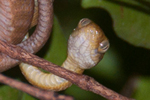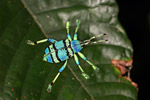
The canopy raft in position for arthropod collection at San Lorenzo. Image courtesy of Roger Le Guen, Laboratory Copyright: Panacoco
Researchers in Panama have published the results of the most comprehensive survey of arthropods in a small area of tropical rainforest. At a high level, the findings surprise no one: the Panamanian rainforest is full of insects, spiders, and crustaceans. Yet the results also show how little is known about this large group of organisms — 60-70 percent of the species are thought to be new to science.
The study, published in the journal Science, involved more than 100 scientists from 21 countries. The researchers collected nearly 130,000 arthropods using a variety of methods between 2003 and 2004, then spent the next eight years sorting and indetifying them. Overall the team found 6,144 arthropod species in the 0.48-hectare research plot. Extrapolating to the entire 6,000-hectare San Lorenzo forest, the researchers estimate the forest contains 25,000 species of arthropods.
 Sample of Panama’s forest arthropod biodiversity. Photos by Rhett A. Butler  Dawn Frame and Alexey Tishechkin in the crane gondola netting insects attracted to flowers of Nectandra purpurascens. Image courtesy of Jürgen Schmidl, Laboratory Copyright: University of Erlangen |
“What surprised us the most was that more than half of all species could be found in a single hectare of the forest,” said the study’s lead author Yves Basset, who serves as the scientific coordinator of the Center for Tropical Forest Sciences Arthropod Initiative at the Smithsonian Tropical Research Institute (STRI) in Panama.
The findings may have implications for estimating the biodiversity of tropical forests, according to Tomas Roslin from the University of Helsinki, one of 35 co-authors of the study.
“[This] means that to determine the species diversity of a tropical rainforest, we need not sample gigantic areas: a total of one hectare may suffice to get an idea of regional arthropod richness – provided that this total includes widely spaced plots representative of variation within the forest,” he said in a statement.
But Terry Erwin, an entomologist at the Smithsonian Institution’s National Museum of Natural History, cautioned about using the number of arthropods at a site in Panama to come up with global biodiversity estimates.
“This study is exciting because they’ve taken a large team of people and used every technique available,” Erwin told Science NOW. “But to take a little sample from one place and scale up, it’s been critiqued and critiqued and it just doesn’t work.”
Erwin wasn’t involved in the study, but published a seminal paper in 1982, where he estimated the world’s forests contained 30 million insect species based on “fogging” an area of Panamanian rainforest with insecticide. His estimate was later undercut by University of Melbourne biologist Andrew Hamilton, who used a similar collection approach in New Guinea, but found substantially lower insect diversity. Hamilton put the global number of insects at 6 million.
However the study may have broader implications for forest ecology and conservation, according to the authors.
“Another exciting finding was that the diversity of both herbivorous and non-herbivorous arthropods could be accurately predicted from the diversity of plants”, said Basset, adding that the research “implies that for every species of vascular plant, bird or mammal in this forest, you will find 20, 83 and 312 species of arthropods, respectively.”

Jürgen Schmidl fogging in the forest understory at San Lorenzo. Image courtesy of Roger Le Guen, Laboratory Copyright: Panacoco
In terms of conservation efforts, Roslin said that focusing on “floristically diverse sites” would protect the most number of arthropods.
“If we are interested in conserving the diversity of life on Earth, we should start thinking about how best to conserve arthropods,” he said.
Citation: Basset, Y., Cizek, L., Cuénoud, P., Didham, R.K, Guilhaumon, F., Missa, O., Novotny, V., Ødegaard, F., Roslin, T., Schmidl, J., Tishechkin, A.K., Winchester, N.N., Roubik, D.W., Aberlenc, H-P., Barrios, H., Bridle, J.R., Castaño-Meneses, G., Corbara, B., Curletti, G., Duarte da Rocha, W., De Bakker, D., Delabie, J.H.C., Dejean, A., Fagan, L.L., Floren, A., A., Kitching, R.L., Medianero, E., Miller, S.E., Gama de Oliveira, E., Orivel, J., Pollet, M., Rapp, M., Ribeiro, S.P., Roisin, Y., Schmidt, J.B., Sørensen, L., Leponce, M. 2012. Arthropod Diversity in a Tropical Forest. Science.
Related articles
New species of bioluminescent cockroach possibly already extinct by volcanic eruption

(11/14/2012) While new species are discovered every day, Peter Vršanský and company’s discovery of a light-producing cockroach, Lucihormetica luckae, in Ecuador is remarkable for many reasons, not the least that it may already be extinct. The new species represents the only known case of mimicry by bioluminescence in a land animal. Like a venomless king snake beating its tail to copy the unmistakable warning of a rattlesnake, Lucihormetica luckae’s bioluminescent patterns are nearly identical to the poisonous click beetle, with which it shares (or shared) its habitat.
Arachnopocalypse: with birds away, the spiders play in Guam

(09/17/2012) The island of Guam is drowning in spiders. New research in the open-access journal PLOS ONE has found that in the wet season, Guam’s arachnid population booms to around 40 times higher than adjacent islands. Scientists say this is because Guam, a U.S. territory in the Pacific, has lost its insect-eating forest birds. Guam’s forests were once rich in birdlife until the invasion of non-native brown tree snake (Boiga irregularis) in the 1940s decimated biodiverse bird communities. Now, the island is not only overrun with snakes, but spiders too.
Biodiversity faltering: 20% of invertebrates threatened with extinction

(08/31/2012) Twenty percent of invertebrates are at risk of extinction, according to a new report that looks at the 12,621 invertebrates assessed by the IUCN Red List to date. Although invertebrates never garner the same conservation attention as big, charismatic animals such as tigers and elephants, they play an undeniable role in maintaining healthy ecosystems. In addition, since invertebrates make-up 80 percent of the world’s species, the report raises new concerns about global biodiversity decline.
Unidentified poodle moth takes Internet by storm

(08/29/2012) A white moth from Venezuela that bears a striking resemblance to a poodle has become an Internet sensation, after cryptozoologist Karl Shuker posted about the bizarre-looking species on his blog. Photographed in 2009 in Venezulea’s Canaima National Park in the Gran Sabana region by zoologist Arthur Anker from Kyrgyzstan, the white, cuddly-looking moth with massive black eyes has yet to be identified and could be a species still unknown to science.
One extinction leads to another…and another

(08/28/2012) A new study in Biology Letters demonstrates that altering the relationship between a predator and its prey can cause wide-ranging ripple effects through an ecosystem, including unexpected extinctions. Species help each other, directly or indirectly, which scientists refer to as mutualism or commensalism. For example, a species’ success may rely not only upon the survival of its food source, but may also indirectly rely upon the survival of more distantly related species.
Scientists discover beautiful new insect species after stumbling upon photos on Flickr
(08/09/2012) Scientists have discovered a previously unknown species of lacewing insect after stumbling upon a series of photos posted on Flickr®, according to a paper published in the journal ZooKeys.
Beyoncé honored with new horse fly named after her
(01/16/2012) Musical artists, and dancer extraordinare, Beyoncé has been awarded a new honor this week: entomologists in Australia have named a new horse fly after the American singer. The new horse fly, dubbed Scaptia beyonceae, is found in Queensland’s Atherton Tablelands.
Colorful insects help search for anti-cancer drugs
(07/07/2008) Brightly-colored beetles or caterpillars feeding on a tropical plant may signal the presence of chemical compounds active against cancer and parasitic diseases, report researchers writing in the journal Frontiers in Ecology and the Environment. The discovery could help speed drug discovery.